Award in Education and Training Level 3 Assignment - Unit 302
VerifiedAdded on 2023/01/03
|8
|2088
|23
Homework Assignment
AI Summary
This assignment, designed for the Award in Education and Training Level 3, Unit 302, explores key aspects of inclusive learning and teaching. It defines inclusive learning and describes its features, emphasizing the importance of adapting to evolving situations. The assignment explains the necessity of creating an inclusive learning environment, detailing how to value diversity, promote equality, and maintain a supportive atmosphere. It highlights the importance of selecting appropriate teaching, learning, and assessment methods to meet individual learner needs, providing examples and comparing the strengths and limitations of various methods such as practical games, discussions, and presentations. The document also addresses the significance of developing learners' English, Mathematics, ICT, and wider skills, along with strategies for engaging and motivating learners. Furthermore, it summarizes the importance of establishing ground rules to foster a structured and safe learning environment, ensuring all learners feel included and respected. The assignment includes references to support the arguments and provide additional resources for further study.
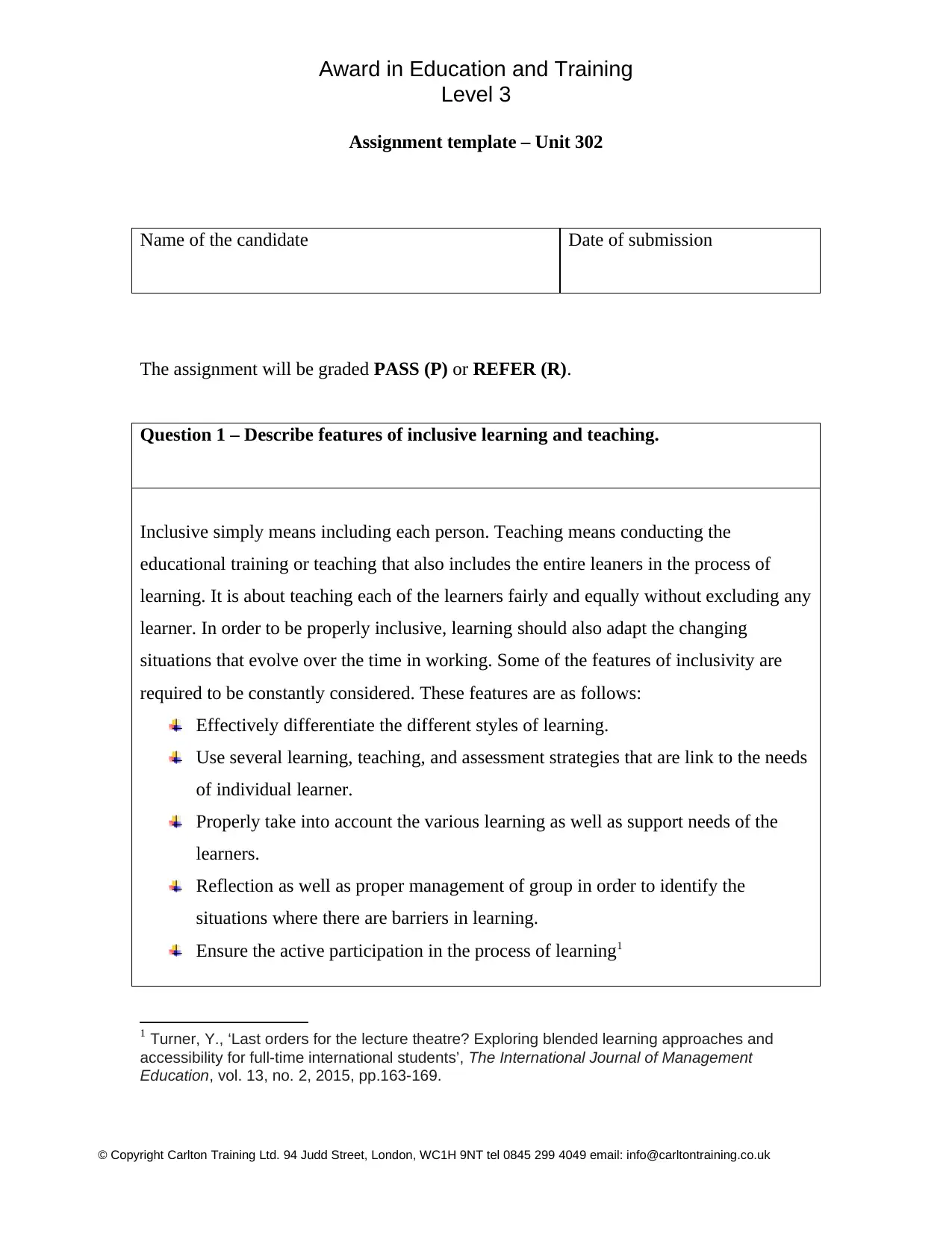
Award in Education and Training
Level 3
Assignment template – Unit 302
Name of the candidate Date of submission
The assignment will be graded PASS (P) or REFER (R).
Question 1 – Describe features of inclusive learning and teaching.
Inclusive simply means including each person. Teaching means conducting the
educational training or teaching that also includes the entire leaners in the process of
learning. It is about teaching each of the learners fairly and equally without excluding any
learner. In order to be properly inclusive, learning should also adapt the changing
situations that evolve over the time in working. Some of the features of inclusivity are
required to be constantly considered. These features are as follows:
Effectively differentiate the different styles of learning.
Use several learning, teaching, and assessment strategies that are link to the needs
of individual learner.
Properly take into account the various learning as well as support needs of the
learners.
Reflection as well as proper management of group in order to identify the
situations where there are barriers in learning.
Ensure the active participation in the process of learning1
1 Turner, Y., ‘Last orders for the lecture theatre? Exploring blended learning approaches and
accessibility for full-time international students’, The International Journal of Management
Education, vol. 13, no. 2, 2015, pp.163-169.
© Copyright Carlton Training Ltd. 94 Judd Street, London, WC1H 9NT tel 0845 299 4049 email: info@carltontraining.co.uk
Level 3
Assignment template – Unit 302
Name of the candidate Date of submission
The assignment will be graded PASS (P) or REFER (R).
Question 1 – Describe features of inclusive learning and teaching.
Inclusive simply means including each person. Teaching means conducting the
educational training or teaching that also includes the entire leaners in the process of
learning. It is about teaching each of the learners fairly and equally without excluding any
learner. In order to be properly inclusive, learning should also adapt the changing
situations that evolve over the time in working. Some of the features of inclusivity are
required to be constantly considered. These features are as follows:
Effectively differentiate the different styles of learning.
Use several learning, teaching, and assessment strategies that are link to the needs
of individual learner.
Properly take into account the various learning as well as support needs of the
learners.
Reflection as well as proper management of group in order to identify the
situations where there are barriers in learning.
Ensure the active participation in the process of learning1
1 Turner, Y., ‘Last orders for the lecture theatre? Exploring blended learning approaches and
accessibility for full-time international students’, The International Journal of Management
Education, vol. 13, no. 2, 2015, pp.163-169.
© Copyright Carlton Training Ltd. 94 Judd Street, London, WC1H 9NT tel 0845 299 4049 email: info@carltontraining.co.uk
Paraphrase This Document
Need a fresh take? Get an instant paraphrase of this document with our AI Paraphraser
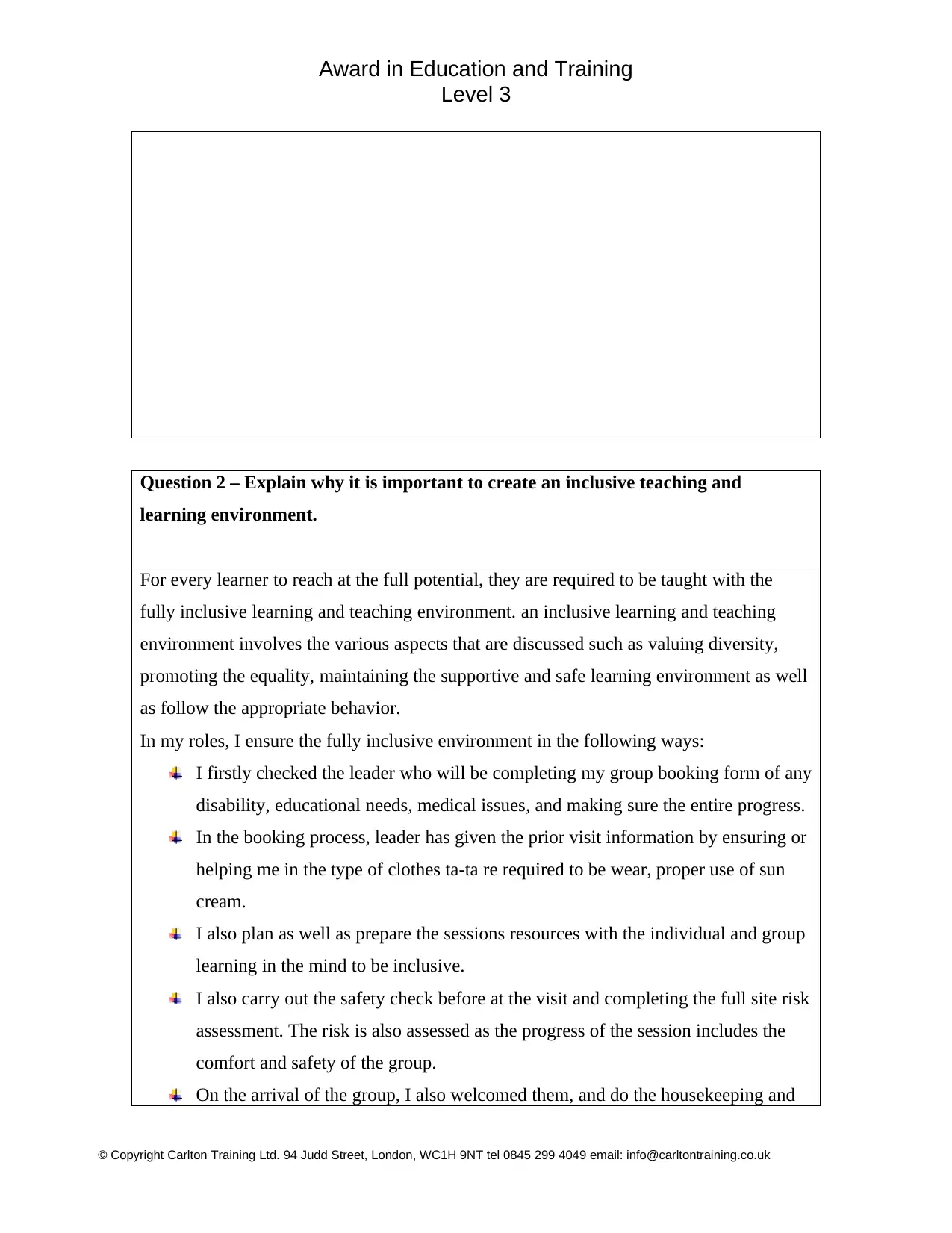
Award in Education and Training
Level 3
Question 2 – Explain why it is important to create an inclusive teaching and
learning environment.
For every learner to reach at the full potential, they are required to be taught with the
fully inclusive learning and teaching environment. an inclusive learning and teaching
environment involves the various aspects that are discussed such as valuing diversity,
promoting the equality, maintaining the supportive and safe learning environment as well
as follow the appropriate behavior.
In my roles, I ensure the fully inclusive environment in the following ways:
I firstly checked the leader who will be completing my group booking form of any
disability, educational needs, medical issues, and making sure the entire progress.
In the booking process, leader has given the prior visit information by ensuring or
helping me in the type of clothes ta-ta re required to be wear, proper use of sun
cream.
I also plan as well as prepare the sessions resources with the individual and group
learning in the mind to be inclusive.
I also carry out the safety check before at the visit and completing the full site risk
assessment. The risk is also assessed as the progress of the session includes the
comfort and safety of the group.
On the arrival of the group, I also welcomed them, and do the housekeeping and
© Copyright Carlton Training Ltd. 94 Judd Street, London, WC1H 9NT tel 0845 299 4049 email: info@carltontraining.co.uk
Level 3
Question 2 – Explain why it is important to create an inclusive teaching and
learning environment.
For every learner to reach at the full potential, they are required to be taught with the
fully inclusive learning and teaching environment. an inclusive learning and teaching
environment involves the various aspects that are discussed such as valuing diversity,
promoting the equality, maintaining the supportive and safe learning environment as well
as follow the appropriate behavior.
In my roles, I ensure the fully inclusive environment in the following ways:
I firstly checked the leader who will be completing my group booking form of any
disability, educational needs, medical issues, and making sure the entire progress.
In the booking process, leader has given the prior visit information by ensuring or
helping me in the type of clothes ta-ta re required to be wear, proper use of sun
cream.
I also plan as well as prepare the sessions resources with the individual and group
learning in the mind to be inclusive.
I also carry out the safety check before at the visit and completing the full site risk
assessment. The risk is also assessed as the progress of the session includes the
comfort and safety of the group.
On the arrival of the group, I also welcomed them, and do the housekeeping and
© Copyright Carlton Training Ltd. 94 Judd Street, London, WC1H 9NT tel 0845 299 4049 email: info@carltontraining.co.uk
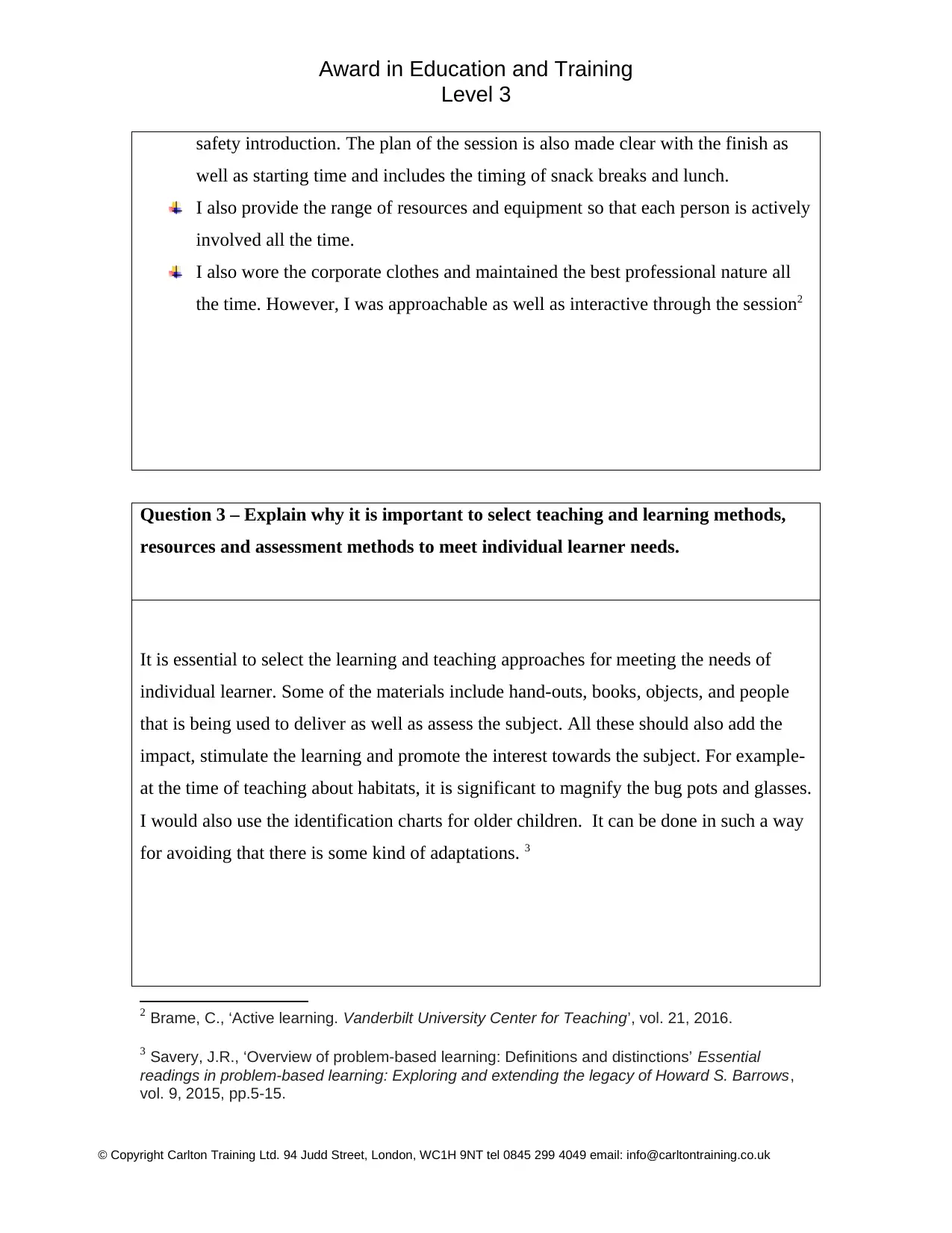
Award in Education and Training
Level 3
safety introduction. The plan of the session is also made clear with the finish as
well as starting time and includes the timing of snack breaks and lunch.
I also provide the range of resources and equipment so that each person is actively
involved all the time.
I also wore the corporate clothes and maintained the best professional nature all
the time. However, I was approachable as well as interactive through the session2
Question 3 – Explain why it is important to select teaching and learning methods,
resources and assessment methods to meet individual learner needs.
It is essential to select the learning and teaching approaches for meeting the needs of
individual learner. Some of the materials include hand-outs, books, objects, and people
that is being used to deliver as well as assess the subject. All these should also add the
impact, stimulate the learning and promote the interest towards the subject. For example-
at the time of teaching about habitats, it is significant to magnify the bug pots and glasses.
I would also use the identification charts for older children. It can be done in such a way
for avoiding that there is some kind of adaptations. 3
2 Brame, C., ‘Active learning. Vanderbilt University Center for Teaching’, vol. 21, 2016.
3 Savery, J.R., ‘Overview of problem-based learning: Definitions and distinctions’ Essential
readings in problem-based learning: Exploring and extending the legacy of Howard S. Barrows,
vol. 9, 2015, pp.5-15.
© Copyright Carlton Training Ltd. 94 Judd Street, London, WC1H 9NT tel 0845 299 4049 email: info@carltontraining.co.uk
Level 3
safety introduction. The plan of the session is also made clear with the finish as
well as starting time and includes the timing of snack breaks and lunch.
I also provide the range of resources and equipment so that each person is actively
involved all the time.
I also wore the corporate clothes and maintained the best professional nature all
the time. However, I was approachable as well as interactive through the session2
Question 3 – Explain why it is important to select teaching and learning methods,
resources and assessment methods to meet individual learner needs.
It is essential to select the learning and teaching approaches for meeting the needs of
individual learner. Some of the materials include hand-outs, books, objects, and people
that is being used to deliver as well as assess the subject. All these should also add the
impact, stimulate the learning and promote the interest towards the subject. For example-
at the time of teaching about habitats, it is significant to magnify the bug pots and glasses.
I would also use the identification charts for older children. It can be done in such a way
for avoiding that there is some kind of adaptations. 3
2 Brame, C., ‘Active learning. Vanderbilt University Center for Teaching’, vol. 21, 2016.
3 Savery, J.R., ‘Overview of problem-based learning: Definitions and distinctions’ Essential
readings in problem-based learning: Exploring and extending the legacy of Howard S. Barrows,
vol. 9, 2015, pp.5-15.
© Copyright Carlton Training Ltd. 94 Judd Street, London, WC1H 9NT tel 0845 299 4049 email: info@carltontraining.co.uk
⊘ This is a preview!⊘
Do you want full access?
Subscribe today to unlock all pages.

Trusted by 1+ million students worldwide
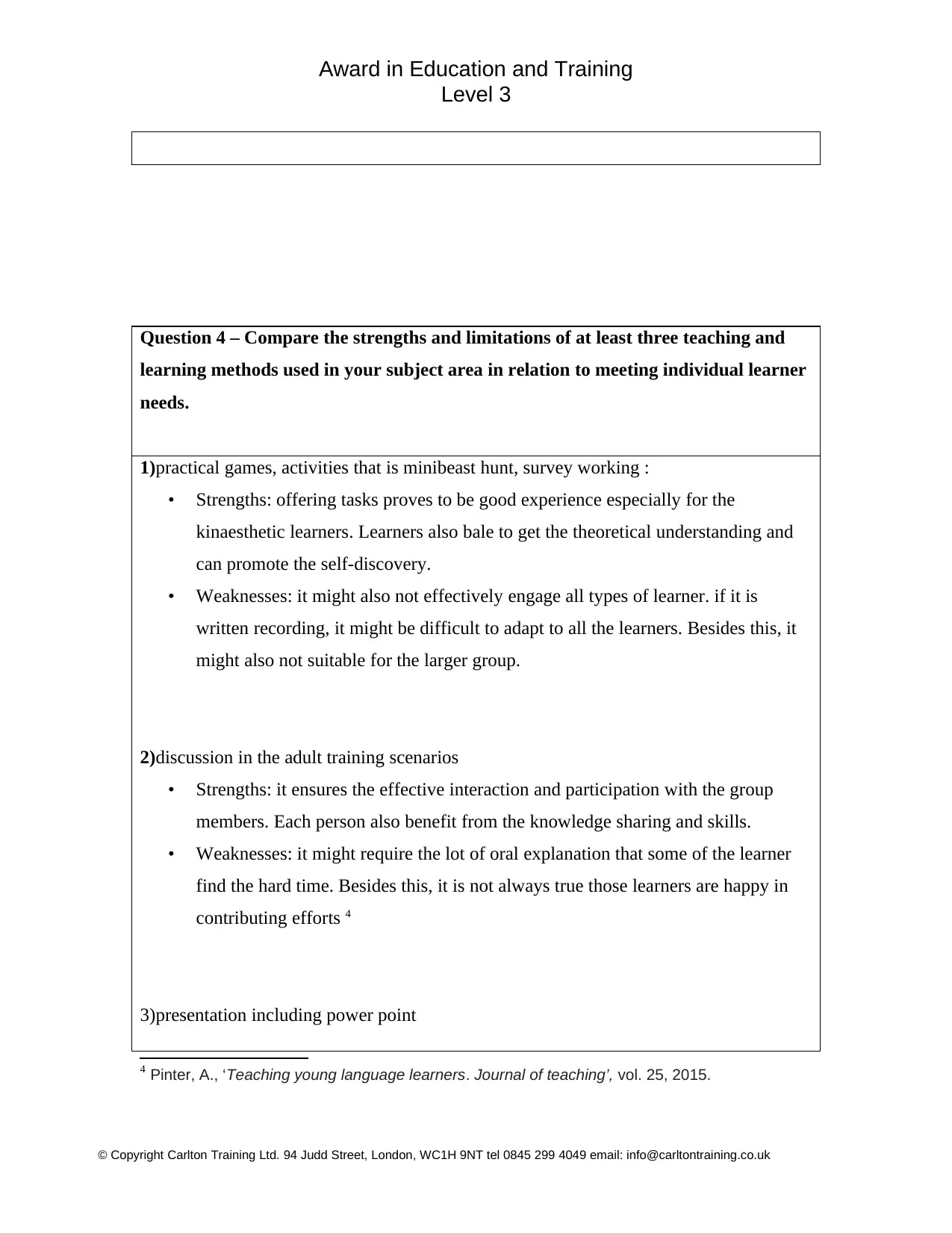
Award in Education and Training
Level 3
Question 4 – Compare the strengths and limitations of at least three teaching and
learning methods used in your subject area in relation to meeting individual learner
needs.
1)practical games, activities that is minibeast hunt, survey working :
• Strengths: offering tasks proves to be good experience especially for the
kinaesthetic learners. Learners also bale to get the theoretical understanding and
can promote the self-discovery.
• Weaknesses: it might also not effectively engage all types of learner. if it is
written recording, it might be difficult to adapt to all the learners. Besides this, it
might also not suitable for the larger group.
2)discussion in the adult training scenarios
• Strengths: it ensures the effective interaction and participation with the group
members. Each person also benefit from the knowledge sharing and skills.
• Weaknesses: it might require the lot of oral explanation that some of the learner
find the hard time. Besides this, it is not always true those learners are happy in
contributing efforts 4
3)presentation including power point
4 Pinter, A., ‘Teaching young language learners. Journal of teaching’, vol. 25, 2015.
© Copyright Carlton Training Ltd. 94 Judd Street, London, WC1H 9NT tel 0845 299 4049 email: info@carltontraining.co.uk
Level 3
Question 4 – Compare the strengths and limitations of at least three teaching and
learning methods used in your subject area in relation to meeting individual learner
needs.
1)practical games, activities that is minibeast hunt, survey working :
• Strengths: offering tasks proves to be good experience especially for the
kinaesthetic learners. Learners also bale to get the theoretical understanding and
can promote the self-discovery.
• Weaknesses: it might also not effectively engage all types of learner. if it is
written recording, it might be difficult to adapt to all the learners. Besides this, it
might also not suitable for the larger group.
2)discussion in the adult training scenarios
• Strengths: it ensures the effective interaction and participation with the group
members. Each person also benefit from the knowledge sharing and skills.
• Weaknesses: it might require the lot of oral explanation that some of the learner
find the hard time. Besides this, it is not always true those learners are happy in
contributing efforts 4
3)presentation including power point
4 Pinter, A., ‘Teaching young language learners. Journal of teaching’, vol. 25, 2015.
© Copyright Carlton Training Ltd. 94 Judd Street, London, WC1H 9NT tel 0845 299 4049 email: info@carltontraining.co.uk
Paraphrase This Document
Need a fresh take? Get an instant paraphrase of this document with our AI Paraphraser
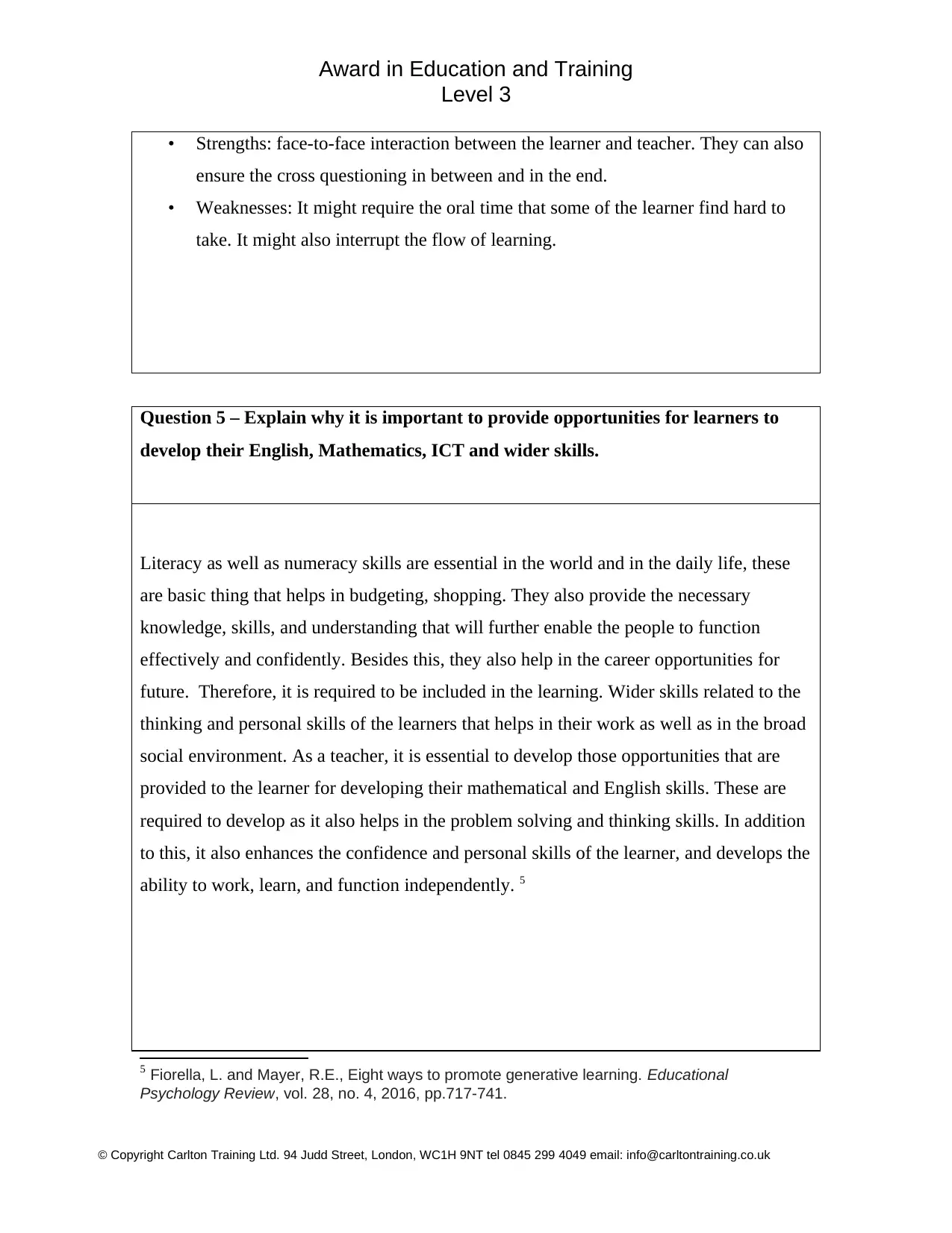
Award in Education and Training
Level 3
• Strengths: face-to-face interaction between the learner and teacher. They can also
ensure the cross questioning in between and in the end.
• Weaknesses: It might require the oral time that some of the learner find hard to
take. It might also interrupt the flow of learning.
Question 5 – Explain why it is important to provide opportunities for learners to
develop their English, Mathematics, ICT and wider skills.
Literacy as well as numeracy skills are essential in the world and in the daily life, these
are basic thing that helps in budgeting, shopping. They also provide the necessary
knowledge, skills, and understanding that will further enable the people to function
effectively and confidently. Besides this, they also help in the career opportunities for
future. Therefore, it is required to be included in the learning. Wider skills related to the
thinking and personal skills of the learners that helps in their work as well as in the broad
social environment. As a teacher, it is essential to develop those opportunities that are
provided to the learner for developing their mathematical and English skills. These are
required to develop as it also helps in the problem solving and thinking skills. In addition
to this, it also enhances the confidence and personal skills of the learner, and develops the
ability to work, learn, and function independently. 5
5 Fiorella, L. and Mayer, R.E., Eight ways to promote generative learning. Educational
Psychology Review, vol. 28, no. 4, 2016, pp.717-741.
© Copyright Carlton Training Ltd. 94 Judd Street, London, WC1H 9NT tel 0845 299 4049 email: info@carltontraining.co.uk
Level 3
• Strengths: face-to-face interaction between the learner and teacher. They can also
ensure the cross questioning in between and in the end.
• Weaknesses: It might require the oral time that some of the learner find hard to
take. It might also interrupt the flow of learning.
Question 5 – Explain why it is important to provide opportunities for learners to
develop their English, Mathematics, ICT and wider skills.
Literacy as well as numeracy skills are essential in the world and in the daily life, these
are basic thing that helps in budgeting, shopping. They also provide the necessary
knowledge, skills, and understanding that will further enable the people to function
effectively and confidently. Besides this, they also help in the career opportunities for
future. Therefore, it is required to be included in the learning. Wider skills related to the
thinking and personal skills of the learners that helps in their work as well as in the broad
social environment. As a teacher, it is essential to develop those opportunities that are
provided to the learner for developing their mathematical and English skills. These are
required to develop as it also helps in the problem solving and thinking skills. In addition
to this, it also enhances the confidence and personal skills of the learner, and develops the
ability to work, learn, and function independently. 5
5 Fiorella, L. and Mayer, R.E., Eight ways to promote generative learning. Educational
Psychology Review, vol. 28, no. 4, 2016, pp.717-741.
© Copyright Carlton Training Ltd. 94 Judd Street, London, WC1H 9NT tel 0845 299 4049 email: info@carltontraining.co.uk
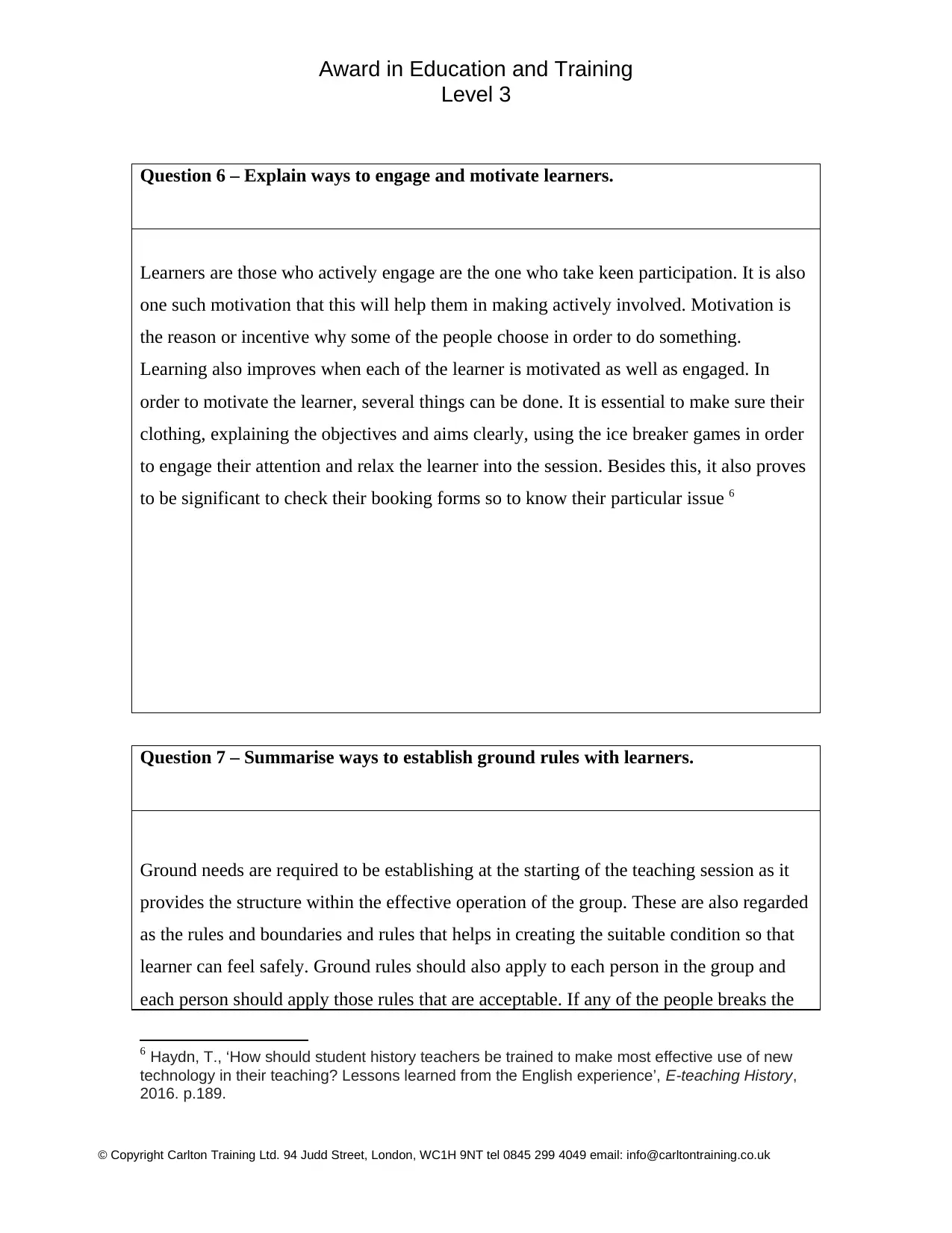
Award in Education and Training
Level 3
Question 6 – Explain ways to engage and motivate learners.
Learners are those who actively engage are the one who take keen participation. It is also
one such motivation that this will help them in making actively involved. Motivation is
the reason or incentive why some of the people choose in order to do something.
Learning also improves when each of the learner is motivated as well as engaged. In
order to motivate the learner, several things can be done. It is essential to make sure their
clothing, explaining the objectives and aims clearly, using the ice breaker games in order
to engage their attention and relax the learner into the session. Besides this, it also proves
to be significant to check their booking forms so to know their particular issue 6
Question 7 – Summarise ways to establish ground rules with learners.
Ground needs are required to be establishing at the starting of the teaching session as it
provides the structure within the effective operation of the group. These are also regarded
as the rules and boundaries and rules that helps in creating the suitable condition so that
learner can feel safely. Ground rules should also apply to each person in the group and
each person should apply those rules that are acceptable. If any of the people breaks the
6 Haydn, T., ‘How should student history teachers be trained to make most effective use of new
technology in their teaching? Lessons learned from the English experience’, E-teaching History,
2016. p.189.
© Copyright Carlton Training Ltd. 94 Judd Street, London, WC1H 9NT tel 0845 299 4049 email: info@carltontraining.co.uk
Level 3
Question 6 – Explain ways to engage and motivate learners.
Learners are those who actively engage are the one who take keen participation. It is also
one such motivation that this will help them in making actively involved. Motivation is
the reason or incentive why some of the people choose in order to do something.
Learning also improves when each of the learner is motivated as well as engaged. In
order to motivate the learner, several things can be done. It is essential to make sure their
clothing, explaining the objectives and aims clearly, using the ice breaker games in order
to engage their attention and relax the learner into the session. Besides this, it also proves
to be significant to check their booking forms so to know their particular issue 6
Question 7 – Summarise ways to establish ground rules with learners.
Ground needs are required to be establishing at the starting of the teaching session as it
provides the structure within the effective operation of the group. These are also regarded
as the rules and boundaries and rules that helps in creating the suitable condition so that
learner can feel safely. Ground rules should also apply to each person in the group and
each person should apply those rules that are acceptable. If any of the people breaks the
6 Haydn, T., ‘How should student history teachers be trained to make most effective use of new
technology in their teaching? Lessons learned from the English experience’, E-teaching History,
2016. p.189.
© Copyright Carlton Training Ltd. 94 Judd Street, London, WC1H 9NT tel 0845 299 4049 email: info@carltontraining.co.uk
⊘ This is a preview!⊘
Do you want full access?
Subscribe today to unlock all pages.

Trusted by 1+ million students worldwide
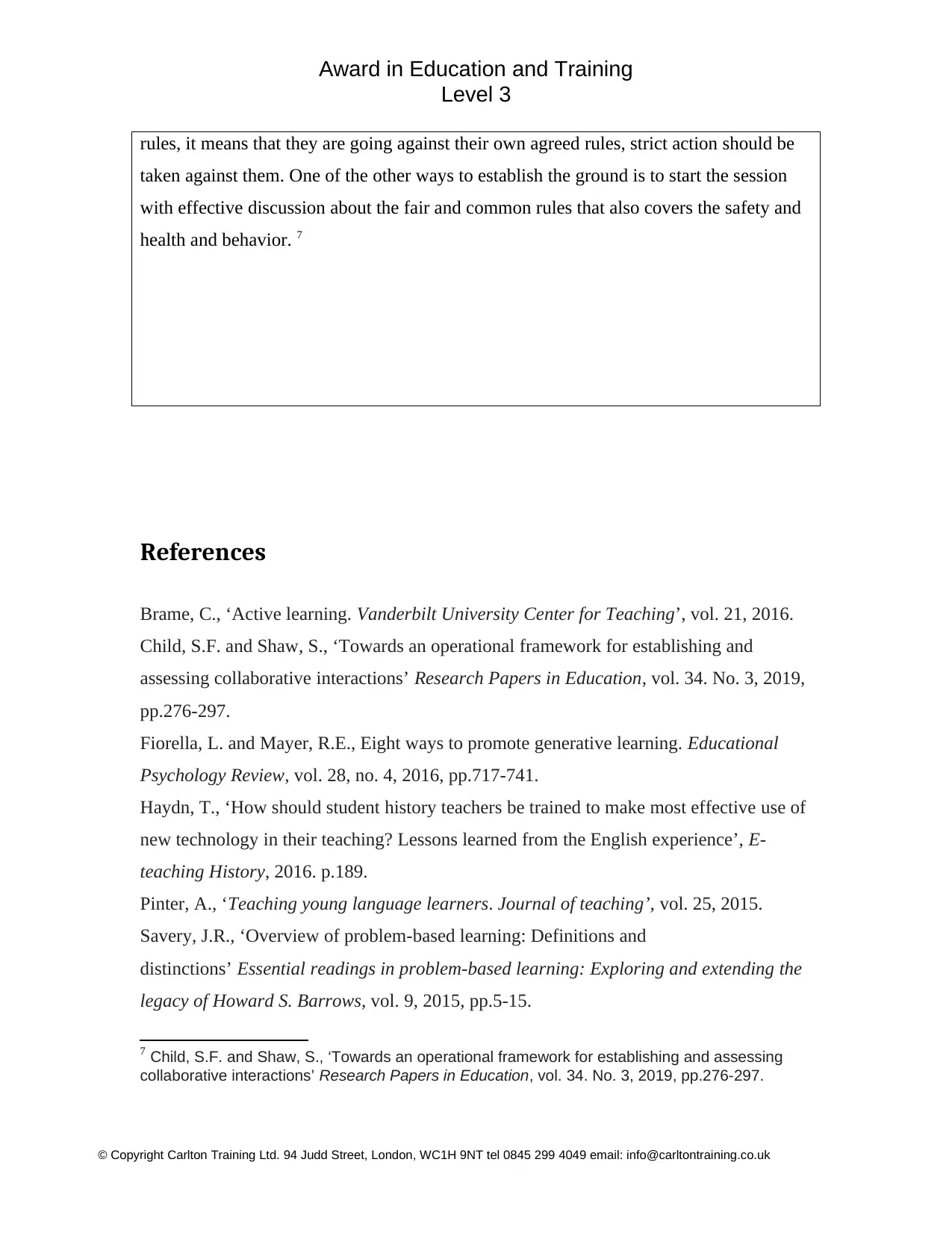
Award in Education and Training
Level 3
rules, it means that they are going against their own agreed rules, strict action should be
taken against them. One of the other ways to establish the ground is to start the session
with effective discussion about the fair and common rules that also covers the safety and
health and behavior. 7
References
Brame, C., ‘Active learning. Vanderbilt University Center for Teaching’, vol. 21, 2016.
Child, S.F. and Shaw, S., ‘Towards an operational framework for establishing and
assessing collaborative interactions’ Research Papers in Education, vol. 34. No. 3, 2019,
pp.276-297.
Fiorella, L. and Mayer, R.E., Eight ways to promote generative learning. Educational
Psychology Review, vol. 28, no. 4, 2016, pp.717-741.
Haydn, T., ‘How should student history teachers be trained to make most effective use of
new technology in their teaching? Lessons learned from the English experience’, E-
teaching History, 2016. p.189.
Pinter, A., ‘Teaching young language learners. Journal of teaching’, vol. 25, 2015.
Savery, J.R., ‘Overview of problem-based learning: Definitions and
distinctions’ Essential readings in problem-based learning: Exploring and extending the
legacy of Howard S. Barrows, vol. 9, 2015, pp.5-15.
7 Child, S.F. and Shaw, S., ‘Towards an operational framework for establishing and assessing
collaborative interactions’ Research Papers in Education, vol. 34. No. 3, 2019, pp.276-297.
© Copyright Carlton Training Ltd. 94 Judd Street, London, WC1H 9NT tel 0845 299 4049 email: info@carltontraining.co.uk
Level 3
rules, it means that they are going against their own agreed rules, strict action should be
taken against them. One of the other ways to establish the ground is to start the session
with effective discussion about the fair and common rules that also covers the safety and
health and behavior. 7
References
Brame, C., ‘Active learning. Vanderbilt University Center for Teaching’, vol. 21, 2016.
Child, S.F. and Shaw, S., ‘Towards an operational framework for establishing and
assessing collaborative interactions’ Research Papers in Education, vol. 34. No. 3, 2019,
pp.276-297.
Fiorella, L. and Mayer, R.E., Eight ways to promote generative learning. Educational
Psychology Review, vol. 28, no. 4, 2016, pp.717-741.
Haydn, T., ‘How should student history teachers be trained to make most effective use of
new technology in their teaching? Lessons learned from the English experience’, E-
teaching History, 2016. p.189.
Pinter, A., ‘Teaching young language learners. Journal of teaching’, vol. 25, 2015.
Savery, J.R., ‘Overview of problem-based learning: Definitions and
distinctions’ Essential readings in problem-based learning: Exploring and extending the
legacy of Howard S. Barrows, vol. 9, 2015, pp.5-15.
7 Child, S.F. and Shaw, S., ‘Towards an operational framework for establishing and assessing
collaborative interactions’ Research Papers in Education, vol. 34. No. 3, 2019, pp.276-297.
© Copyright Carlton Training Ltd. 94 Judd Street, London, WC1H 9NT tel 0845 299 4049 email: info@carltontraining.co.uk
Paraphrase This Document
Need a fresh take? Get an instant paraphrase of this document with our AI Paraphraser

Award in Education and Training
Level 3
Turner, Y., ‘Last orders for the lecture theatre? Exploring blended learning approaches
and accessibility for full-time international students’, The International Journal of
Management Education, vol. 13, no. 2, 2015, pp.163-169.
© Copyright Carlton Training Ltd. 94 Judd Street, London, WC1H 9NT tel 0845 299 4049 email: info@carltontraining.co.uk
Level 3
Turner, Y., ‘Last orders for the lecture theatre? Exploring blended learning approaches
and accessibility for full-time international students’, The International Journal of
Management Education, vol. 13, no. 2, 2015, pp.163-169.
© Copyright Carlton Training Ltd. 94 Judd Street, London, WC1H 9NT tel 0845 299 4049 email: info@carltontraining.co.uk
1 out of 8
Your All-in-One AI-Powered Toolkit for Academic Success.
+13062052269
info@desklib.com
Available 24*7 on WhatsApp / Email
![[object Object]](/_next/static/media/star-bottom.7253800d.svg)
Unlock your academic potential
Copyright © 2020–2025 A2Z Services. All Rights Reserved. Developed and managed by ZUCOL.